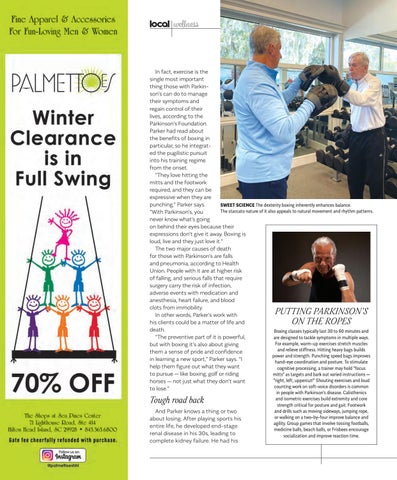wellness
In fact, exercise is the single most important thing those with Parkinson’s can do to manage their symptoms and regain control of their lives, according to the Parkinson’s Foundation. Parker had read about the benefits of boxing in particular, so he integrated the pugilistic pursuit into his training regime from the onset. “They love hitting the mitts and the footwork required, and they can be expressive when they are punching,” Parker says. SWEET SCIENCE The dexterity boxing inherently enhances balance. The staccato nature of it also appeals to natural movement and rhythm patterns. “With Parkinson’s, you never know what’s going on behind their eyes because their expressions don’t give it away. Boxing is loud, live and they just love it.” The two major causes of death for those with Parkinson’s are falls and pneumonia, according to Health Union. People with it are at higher risk of falling, and serious falls that require surgery carry the risk of infection, adverse events with medication and anesthesia, heart failure, and blood clots from immobility. In other words, Parker’s work with his clients could be a matter of life and death. Boxing classes typically last 30 to 60 minutes and “The preventive part of it is powerful, are designed to tackle symptoms in multiple ways. For example, warm-up exercises stretch muscles but with boxing it’s also about giving and relieve stiffness. Hitting heavy bags builds them a sense of pride and confidence power and strength. Punching speed bags improves in learning a new sport,” Parker says. “I hand-eye coordination and posture. To stimulate help them figure out what they want cognitive processing, a trainer may hold "focus to pursue — like boxing, golf or riding mitts" as targets and bark out varied instructions — "right, left, uppercut!" Shouting exercises and loud horses — not just what they don’t want counting work on soft-voice disorders is common to lose.”
PUTTING PARKINSON’S ON THE ROPES
Tough road back And Parker knows a thing or two about losing. After playing sports his entire life, he developed end-stage renal disease in his 30s, leading to complete kidney failure. He had his
60
LocalLifeSC.com + MARCH 2021
in people with Parkinson's disease. Calisthenics and isometric exercises build extremity and core strength critical for posture and gait. Footwork and drills such as moving sideways, jumping rope, or walking on a two-by-four improve balance and agility. Group games that involve tossing footballs, medicine balls, beach balls, or Frisbees encourage socialization and improve reaction time.
